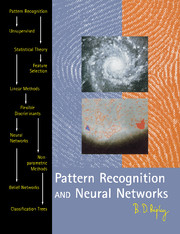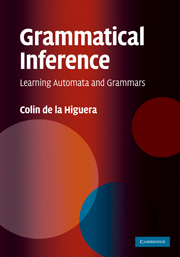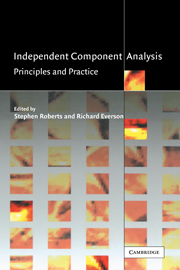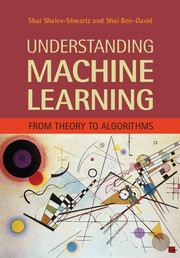Refine search
Actions for selected content:
2327 results in Pattern Recognition and Machine Learning
12 - Efficient Optimisation of a Large Financial Portfolio
-
- Book:
- Large Sample Covariance Matrices and High-Dimensional Data Analysis
- Published online:
- 05 April 2015
- Print publication:
- 26 March 2015, pp 260-290
-
- Chapter
- Export citation
9 - Testing Hypotheses of Equality of Covariance Matrices
-
- Book:
- Large Sample Covariance Matrices and High-Dimensional Data Analysis
- Published online:
- 05 April 2015
- Print publication:
- 26 March 2015, pp 140-171
-
- Chapter
- Export citation
Contents
-
- Book:
- Large Sample Covariance Matrices and High-Dimensional Data Analysis
- Published online:
- 05 April 2015
- Print publication:
- 26 March 2015, pp vii-x
-
- Chapter
- Export citation
Index
-
- Book:
- Large Sample Covariance Matrices and High-Dimensional Data Analysis
- Published online:
- 05 April 2015
- Print publication:
- 26 March 2015, pp 307-308
-
- Chapter
- Export citation
4 - The Generalised Variance and Multiple Correlation Coefficient
-
- Book:
- Large Sample Covariance Matrices and High-Dimensional Data Analysis
- Published online:
- 05 April 2015
- Print publication:
- 26 March 2015, pp 51-61
-
- Chapter
- Export citation
Preface
-
- Book:
- Large Sample Covariance Matrices and High-Dimensional Data Analysis
- Published online:
- 05 April 2015
- Print publication:
- 26 March 2015, pp xiii-xiv
-
- Chapter
- Export citation
7 - Testing the General Linear Hypothesis
-
- Book:
- Large Sample Covariance Matrices and High-Dimensional Data Analysis
- Published online:
- 05 April 2015
- Print publication:
- 26 March 2015, pp 105-123
-
- Chapter
- Export citation
References
-
- Book:
- Large Sample Covariance Matrices and High-Dimensional Data Analysis
- Published online:
- 05 April 2015
- Print publication:
- 26 March 2015, pp 301-306
-
- Chapter
- Export citation
2 - Limiting Spectral Distributions
-
- Book:
- Large Sample Covariance Matrices and High-Dimensional Data Analysis
- Published online:
- 05 April 2015
- Print publication:
- 26 March 2015, pp 7-31
-
- Chapter
- Export citation

Pattern Recognition and Neural Networks
-
- Published online:
- 05 August 2014
- Print publication:
- 18 January 1996

Grammatical Inference
- Learning Automata and Grammars
-
- Published online:
- 05 July 2014
- Print publication:
- 01 April 2010

Independent Component Analysis
- Principles and Practice
-
- Published online:
- 05 July 2014
- Print publication:
- 01 March 2001

Kernel Methods and Machine Learning
-
- Published online:
- 05 July 2014
- Print publication:
- 17 April 2014

Understanding Machine Learning
- From Theory to Algorithms
-
- Published online:
- 05 July 2014
- Print publication:
- 19 May 2014
9 - Linear Predictors
- from Part 2 - From Theory to Algorithms
-
- Book:
- Understanding Machine Learning
- Published online:
- 05 July 2014
- Print publication:
- 19 May 2014, pp 89-100
-
- Chapter
- Export citation
28 - Proof of the Fundamental Theorem of Learning Theory
- from Part 4 - Advanced Theory
-
- Book:
- Understanding Machine Learning
- Published online:
- 05 July 2014
- Print publication:
- 19 May 2014, pp 341-350
-
- Chapter
- Export citation
26 - Rademacher Complexities
- from Part 4 - Advanced Theory
-
- Book:
- Understanding Machine Learning
- Published online:
- 05 July 2014
- Print publication:
- 19 May 2014, pp 325-336
-
- Chapter
- Export citation
18 - Decision Trees
- from Part 2 - From Theory to Algorithms
-
- Book:
- Understanding Machine Learning
- Published online:
- 05 July 2014
- Print publication:
- 19 May 2014, pp 212-218
-
- Chapter
- Export citation
23 - Dimensionality Reduction
- from Part 3 - Additional Learning Models
-
- Book:
- Understanding Machine Learning
- Published online:
- 05 July 2014
- Print publication:
- 19 May 2014, pp 278-294
-
- Chapter
- Export citation
8 - The Runtime of Learning
- from Part 1 - Foundations
-
- Book:
- Understanding Machine Learning
- Published online:
- 05 July 2014
- Print publication:
- 19 May 2014, pp 73-86
-
- Chapter
- Export citation
